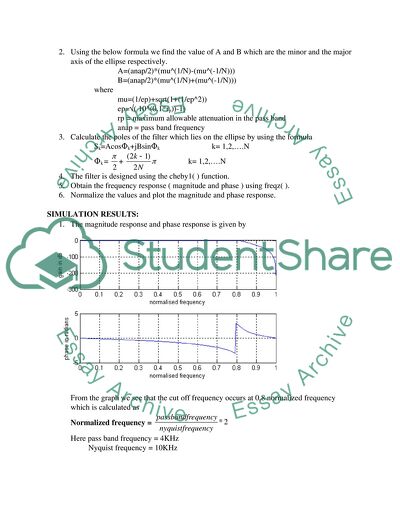
- Home
- Free Samples
- Premium Essays
- Editing Services
- Extra Tools
- Essay Writing Help
- About Us
- Studentshare
- Subjects
- Miscellaneous
- Coursework
Coursework - Essay Example

- Subject: Miscellaneous
- Type: Essay
- Level: Undergraduate
- Pages: 4 (1000 words)
- Downloads: 0
- Author: loren14
Extract of sample "Coursework"
There are two types of chebychev filters, TYPE 1 and TYPE 2. in TYPE 1 ripples are present in the pass band. Transfer function will have only poles. Hence TYPE 1 filter is called all pole transfer function. The traditional approach to infinite impulse response (IIR) filter implementation is to first design a conventional IIR filter to double-precision accuracy in the pole and zero locations and then iteratively adjust the poles and zeros in the design for the target implementation technology (breadboard components, switched capacitor, custom integrated circuit, digital signal processor, heterogeneous, and so forth).
Due to the implementation technology, it is possible for a stable filter to become unstable due to the truncation of the pole and zero locations. A key technology-independent measure of a filters robustness under implementation is a quality factor. A quality factor is associated with each conjugate pair of poles. For analog filters, the quality factor is the radius of the pole divided by -2 times its real part. The quality factor varies from 0.5 (purely real pole; 100% damping) and infinity (imaginary pole; 100% oscillator).
The approximate technology limits are 10 (low-end breadboard components and 8-bit microcontrollers), 25 (high-end breadboard components and 16-bit digital signal processor), and 40 (switched capacitor). A recurring problem in filter implementation is that the conventional filter design formulas yield filters with quality factors in the 40-80 range, even for low filter orders. For example, using the elliptic filter design formulas, Matlab returns a 4th-order elliptic filter with quality factors 1.
7 and 61 for a given magnitude specification. This filter can only be realized with expensive custom integrated circuitry or 32-bit floating-point processors (using sampling and quantization). The quality factor for our design is found to be 2.5798. We can formulate filter optimization as a Sequential Quadratic Programming
...Download file to see next pages Read MoreCHECK THESE SAMPLES OF Coursework
Budgeting Coursework
Resit Coursework
Submitting All Coursework on Time
Business Coursework: Instruction Manual
Content Writing of Coursework
Probability Plc and Netplay Tv Plc - Financial Statement Analysis

- TERMS & CONDITIONS
- PRIVACY POLICY
- COOKIES POLICY